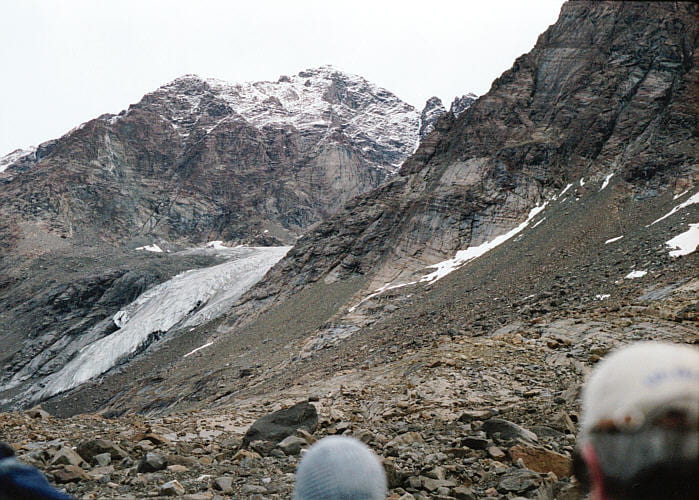Foundered roof blocks are found extensively in LZb, LZc, and the MZ, and less commonly elsewhere. Blocks range from a few centimeters in size from a few centimeters to giant blocks at least 400 m across. The rock of these autoliths is generally more plagioclase-rich than the enclosing lower zone host rocks, suggesting that the roof region from which the blocks must be derived was less efficient at trapping the denser mafic minerals, or perhaps that the roof region was enriched in plagioclase crystals that preferentially escaped deposition on the pluton walls and floor.
Because the Upper Border Series (roof zone) large-scale layering is essentially a mirror image of that of the Layered Series (floor zone), the foundered roof blocks can be assigned to a particular stratigraphic order. This concept predicts, and it is found to be true, that the foundered blocks usually have mineralogy similar to the enclosing or older rocks in the stratigraphy. Roof rocks can also contain blocks. These must have detached, been carried laterally, and entrapped in the progressively solidifying roof zone. Though I saw no upper zone rocks in place except a little UBZ? on Nunatak 1, one large foundered block we saw in the MZ, on Kramer Island, did itself contain such blocks.
West end of Pukugagryggen
View to the northwest toward Wager’s Top, from the landing area on the shore of Uttental Sund. Visible below Wagers Top are the Triple Group layers, highlighted by snow, and the largest known autolith to the upper right of the glacier (for better photos see Irvine et al. (1998, Figs. 14B and 20), Andersen et al. (1998, Figure 2), and Irvine et al. (2001b, Plate 22A). On the flanks of Pukugagryggen, the mountain to the right, the Triple Group is visible near the upper right of the photo, and a bit lower down is a large autolith. Below the autolith is a prominent macrorhythmic section that can also be (barely) discerned on Wagers Top, where the beds lap up onto the giant autolith. These rocks, are all in the MZ. Click on the arrows to see large autolith locations (red A’s), Triple Group locations (red lines), and the macrorhythmic layering section (blue markers).

Looking north toward the prominent macrorhythmic layering section on the lower west flank of Pukugagryggen. When we were on them, the Triple Group members were rather hard to distinguish; they are easier to see from far away
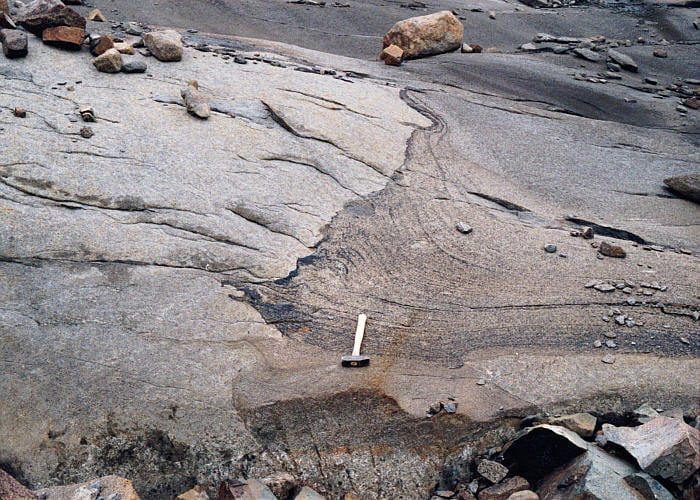
Cumulate beds lapping up on the margin of a large anorthositic autolith, near the Zodiac landing place at the foot of Pukugagryggen. These were deposited by currents that were forced to flow up, over, and around the block as it protruded from the pluton floor.
250 m long autolith block on Kraemer Island

The south end of a very large layered gabbro autolith, ~250 m long, that extends along the coast of Uttental Sund on the east shore of Kramer Island. This giant autolith block is not on the McBirney (1989) map. This block contains numerous smaller blocks, demonstrating the entrapment of blocks during roof zone crystallization. The light-colored block in the middle of this photo is a gabbroic troctolite autolith within the giant block (identified as item 1 on Figure 17, and also shown in Figures 18A and 19A, of Irvine et al., 1998). This gabbroic troctolite has plagioclase with An74, which is the most primitive autolith and rock in the Skaergaard, and probably represents a piece of UBZT. The giant host gabbro block is equivalent to the MZ, UBZ?, containing no cumulus olivine.

Here is the southern end of the giant gabbro block, with layered MZ rocks are lapping up against the gabbro block side. The small gabbroic troctolite block in the photo above is also visible to the right of the man.
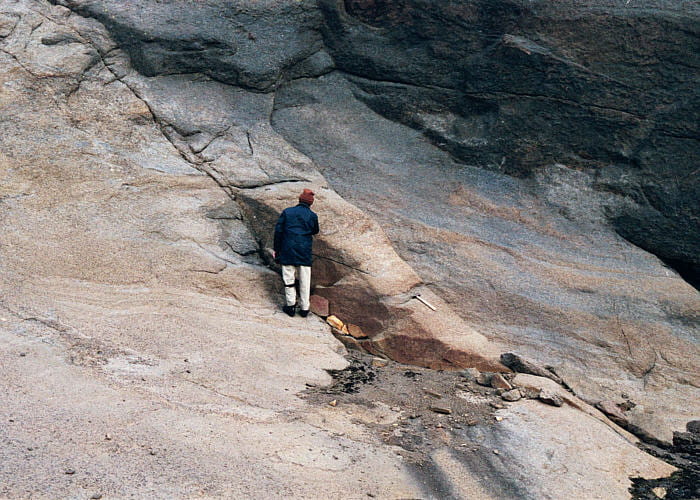
This is the block interior, with diffuse layering seen below the man’s feet and to his right.
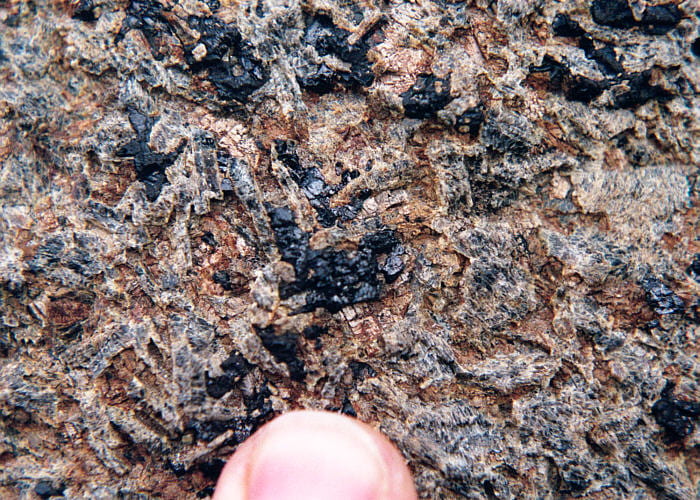
Close-up of a particularly coarse zone, visible just to the left of the man’s knees in the photo immediately above. This coarse rock rests on finer-grained layered rock, also visible in the photo above. Mineralogy includes magnetite, plagioclase, and pyroxene. Thin section here.
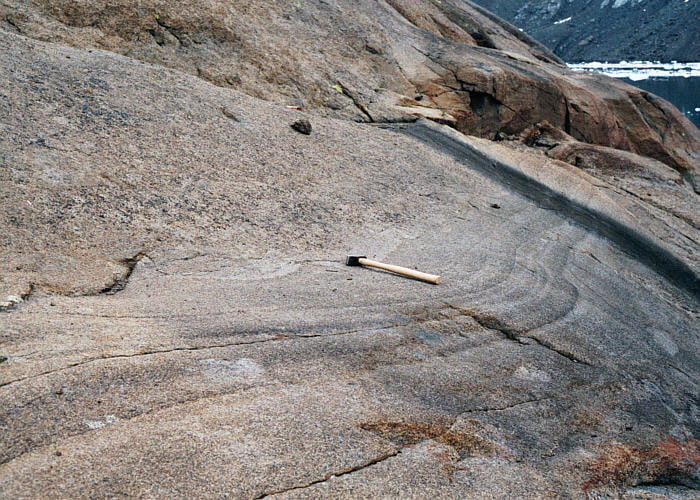
Looking northeast along the gabbro block, showing some finer-grained layered rock, and the coarser grained rock above it.

Graded layering within the giant gabbro autolith. Note that the layers are normally graded, with mafic bottoms and felsic tops. The layering on the roof therefore grades the same way as layering on the floor. The block is cut by a thin basaltic dike.

A small autolith block in the giant gabbro block. Up is to the left, so the draping of layers around the felsic autolith is from the bottom. This is the same autolith as that shown in Figure 19D of Irvine et al. (1998).

Numerous small gabbroic troctolite autoliths in the giant gabbro block.

Angular autolith in the giant gabbroic block. The autolith base looks like replacement anorthositic gabbro, but the other layers are clear enough. The layering in the host block is at a small angle (~20°) to the layering in the included block, indicating block rotation prior to entrapment. this block also has a very primitive composition and is presumably from UBZT.
Various places on eastern Kraemer Island
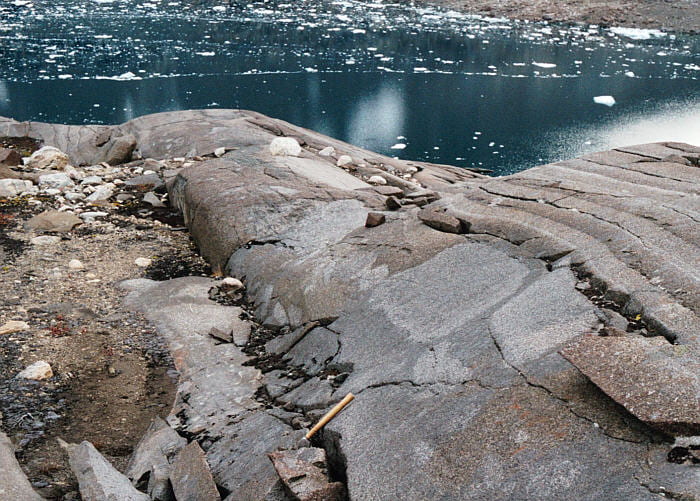
Autoliths strewn in a layer in the lower part of the MZ. This suggests that blocks were distributed laterally by a current, rather than falling into a pile.

Base of medium size autolith block in LZc, showing irregular block shape, and disturbed graded beds below the block.

A small autolith in LZc, showing some deformation below the block, and thinned layers arching over the top.

View across a gully eroded in a basaltic dike. This shows the sharp upper point of an autolith (center), with thinned layers draped over the top and sides. Another medium size block lies stratigraphically above this one in the upper-middle to upper-left.

Graded layer with abundant autoliths strewn within it. Again, this implies that they were distributed by currents.

A block with slightly deformed layers below, and mafic pegmatite at the block bottom. Pegmatite on block bottoms was fairly common, implying that the blocks were relatively impermeable to upward-percolating liquids.

An impressively dense swarm of blocks enclosed in dark-brown MZ mush.
Medium size autolith block, eastern Kraemer Island
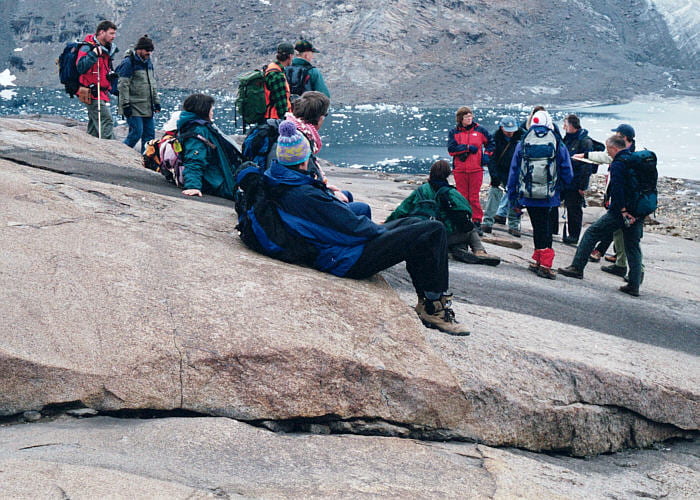
Bottom contact (under the nearest feet) of a gabbroic anorthosite autolith (right) hosted in MZ gabbro (left). The autolith is probably from UBZβ. Diffuse and disturbed layering in underlying rocks to the left may be related to block impact. View is to the east with Uttental Sund in the background.

A sheath fold (or jelly-roll?) immediately below and to one side of the block. This is some of the deformation that occurred in the underlying Layered Series mush at the time of block impact.
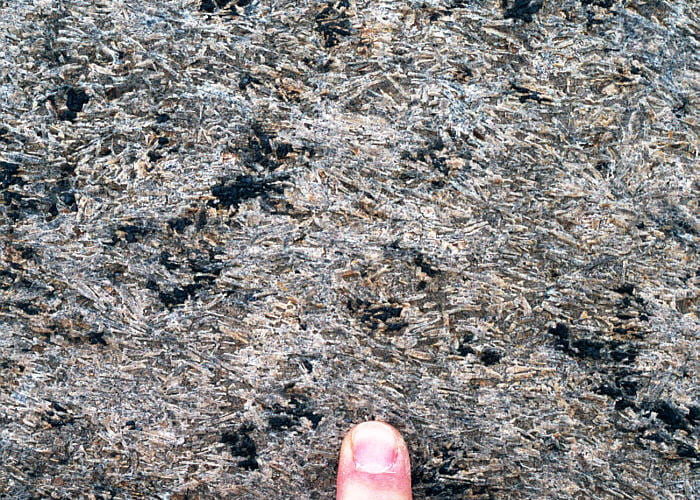
Close-up of the interior of the block, showing that it is very coarse-grained, with a distinct plagioclase foliation. The mineralogy is cumulus plagioclase and pyroxene with oikocrystic magnetite and interstitial olivine.

The block is to the top left, just behind the yellow jacket. This shows numerous smaller blocks that lie on top of the larger one. Many of these have olivine- and oxide-rich reaction rinds, with layering lapping up the block sides.

Close-up view of an irregular block (gray) with a magnetite-rich reaction rind and brown MZ layers lapping up on the block sides.

Several blocks in the MZ, amidst brown-weathering Lower Zone matrix. The foreground block has a clearly truncated rusty-weathering layer. There are also truncations of less obvious layers elsewhere.
A block on southeastern Kraemer Island

A medium-size block, looking east at the down-folded layers beneath the it, with some of the underside deformation visible to the left. Wager’s Top is peeking up over the near horizon. This is the same autolith as that shown in Irvine et al. (1998, Figures 14C and D).

Close-up view of the bottom of the block in the photo above, showing deformed layers and thin magnetite veins.

Close-up view of the north end of the block in the photo immediately above, showing material squished-out from the block underside. Also visible are downwardly-deformed layers to the lower right, contorted layers in the lower center, and upward lapping, post-impact layers to the left.
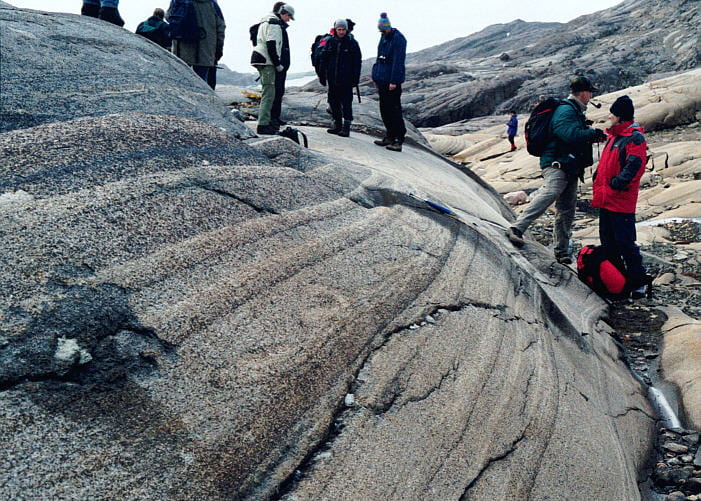
Contorted layer north of the block in the above photos. This contorted layer is some of the poorly consolidated floor material that squirted out from under the block at the time of impact, highlighting the impact horizon. The beds below are not very regular, possibly because this area has a great many blocks.
Autolith in the Middle Zone, southeastern Kraemer Island

The man is standing on a gabbroic autolith. Stratigraphic tops are to the left, so the rusty layer is interpreted to be an olivine-bearing reaction rind on the bottom of the block. There was quite a bit of argument that the reaction rind might actually be on the top of the underlying block to the lower right, which is mostly obscured by water. Strongly layered area to the right of the man (our perspective, not his) is trough filling at the block margin. This is the same area as in Irvine et al. (1998, Figure 23) and Irvine et al. (2001b, Figure 21).
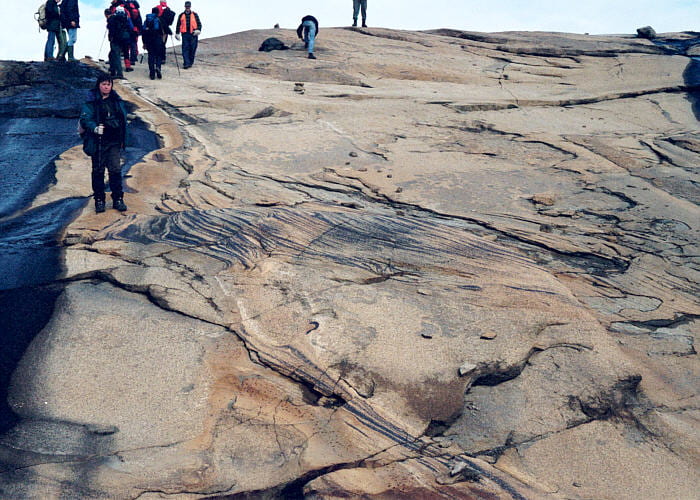
Same area as the image immediately above, but from the south and below. The large gabbro autolith is to the upper right, with the magnetite-rich trough layers on the block margin in the center. The olivine-rich reaction rind extends from the upper-left to bottom-center, with an offset along the irregular top of the underlying block or blocks. Near woman is standing on the rusty rind, and to her right (your left) is the underlying block, mostly wet, and there is probably yet another block in front of her at the rind offset.

Close-up of onlapping magnetite-rich layering on the south side of another block just south of the blocks in the photos above, in an area shown by Irvine et al. (2001b, labeled “6” in Figure 21).
Medium-size autolith, southeastern Kraemer Island
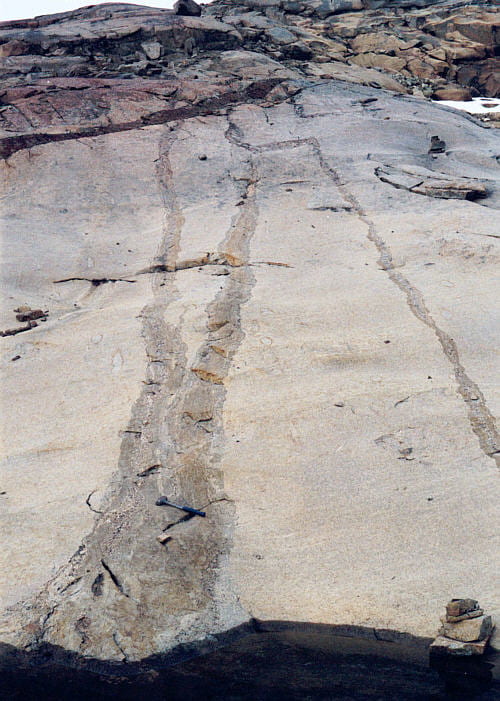
View from below of three dikes cutting an autolith block from UBZT. The dikes are truncated at the block margins, and so must pre-date block foundering. In addition, small anorthositic replacement patches are visible, and a few of these are cut by the dikes and therefore themselves formed in the roof zone prior to dike emplacement. This is the same autolith shown in Irvine et al. (1998, Figures 21 and 22).

A close view of one of the pre-detachment dikes, crosscutting this block. Notice how the dike has irregular layers near the margins and becomes coarse toward its interior.

Lower ends of two of the dikes (here adjacent) at the block bottom, where the block and dikes terminate against MZ gabbro. The pencil tip is at the contact between the MZ gabbros below, and the dikes and block above.

Mushroom-shaped anorthositic replacement bodies in the block of this section. These are viewed from the bottom of the block, so the mushroom caps are up. These replacement bodies are elsewhere cut by the pre-detachment dikes, and so predate them, and also block detachment. Notice how the anorthositic material has more mafic margins in their lower parts, but not at the caps.

Looking south at the overfolded and disrupted layering on the underside of the medium sized block in this photo set. The block itself is the light colored rock in the middle-right. This is essentially the same photo as in Irvine et al. (1998, Figure 12C).

Eastward view toward Basistoppen. The foreground is the ridge on the southeast margin of Kramer Island, just east of the small pond at an elevation of 17 m. The light-colored rock on the left half of the ridge is a giant autolith, with onlapping macrorhythmic layering visible on the right side. This giant block does not seem to be on the McBirney (1989) map, though the map shows another very large autolith farther to the north.
